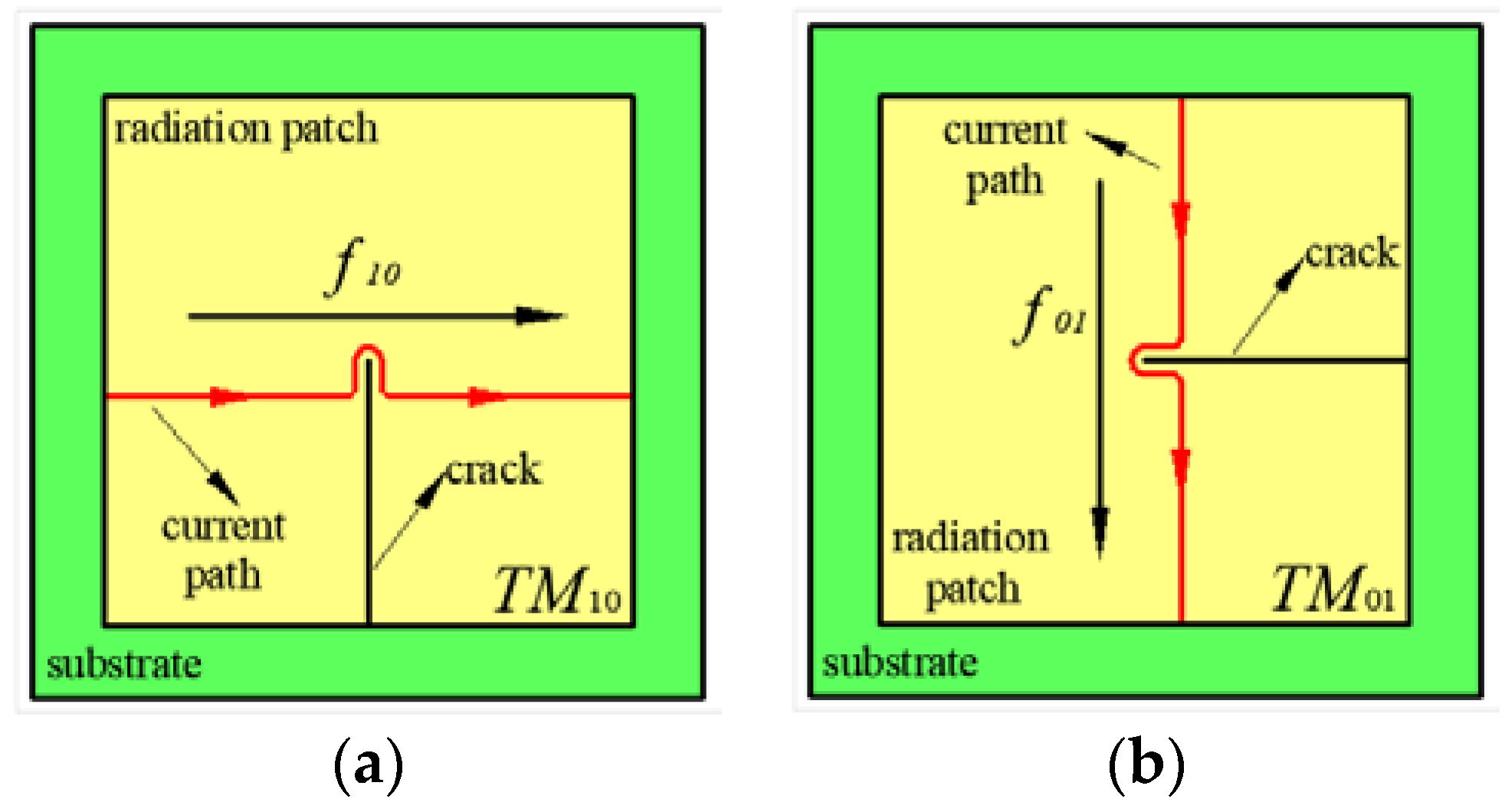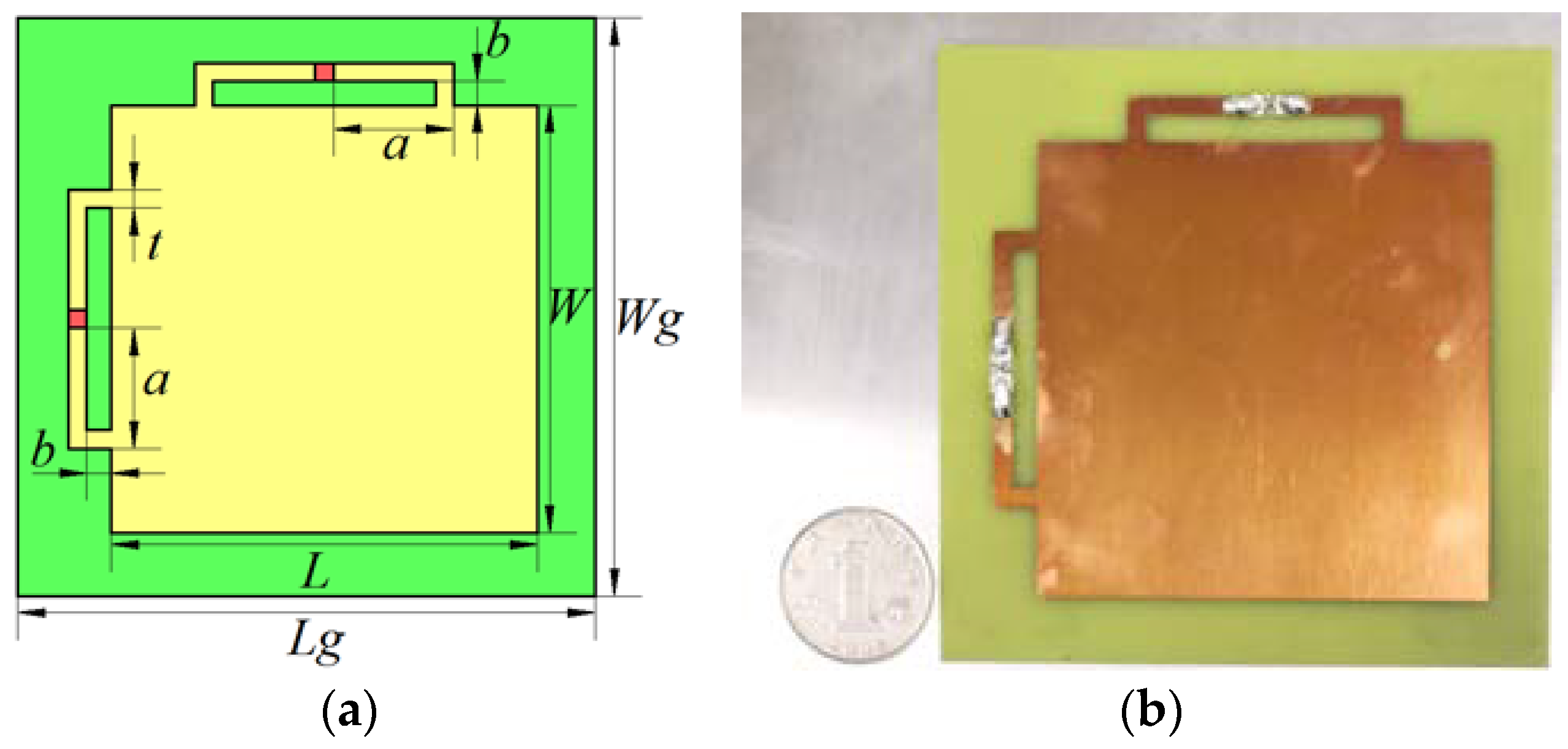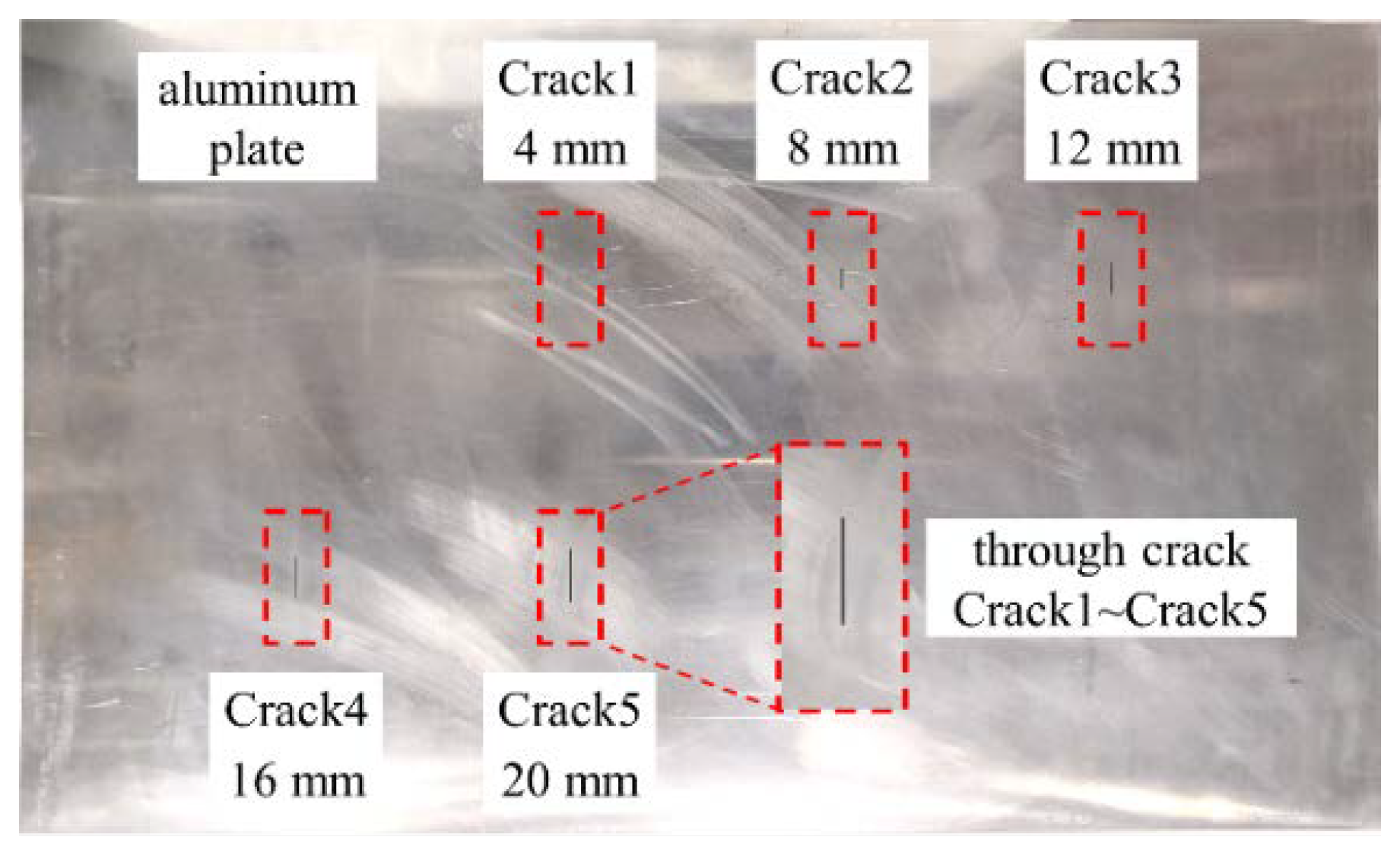Method of Monitoring Cracks in a Metal Structure Based on Dual-Chip RFID Antenna Sensor †
Abstract
:1. Introduction
2. Materials and Methods
2.1. Principle of Crack Identification
2.2. Simulations of Crack Identification
2.3. Experiments of Crack Identification
3. Results
3.1. Results of Simulations
3.2. Results of Experiments
4. Conclusions
- When there is no crack in the ground plate, certain differences exist amongst the measurement results of the resonant frequency of the antenna sensor under different transmission powers. However, the resonant frequency value is essentially kept within a small fluctuation range, and the accuracy of the test results can be ensured by average multiple measurements.
- In the crack identification experiment, when the transmission power of the RFID reader changes, there is a slight difference in the amount of the resonant length change corresponding to the same crack length. However, this difference has no influence on the identification of crack defects. When the transmission power of the reader is constant, the crack length of the ground plate and the resonant length of the sensor maintain a good parabolic relationship.
- The wireless test results reveal that the antenna sensor achieved good performance in wirelessly identifying cracks on a metal structure; the wireless identification distance can reach 1.96 m.
Author Contributions
Acknowledgments
Conflicts of Interest
References
- Cunfu, H.; Tianting, Y.; Guorong, S.; Yan, L.; Bin, W. Design and optimization of a strain sensor based on rectangular micro-strip patch antenna. Chin. J. Sci. Instrum. 2017, 38, 361–367. [Google Scholar]
- Kai, Z.; Zhiping, L.; Yanfei, M.; Puping, K.; Liang, K. Plane two-dimensional strain measurement method of patch antenna sensor. Chin. J. Sci. Instrum. 2018, 39, 136–143. [Google Scholar] [CrossRef]
- Deshmukh, S.; Mohammad, I.; Tentzeris, M.; Wu, T.; Huang, H. Crack Detection and Monitoring Using Passive Wireless Sensor. In Proceedings of the ASME 2009 Conference on Smart Materials, Adaptive Structures and Intelligent Systems, Oxnard, CA, USA, 21–23 September 2009; pp. 511–516. [Google Scholar]
- Yi, X.; Cho, C.; Wang, Y.; Cook, B.; Tentzeris, M.; Leon, R. Crack Propagation Measurement Using a Battery-Free Slotted Patch Antenna Sensor. In Proceedings of the 7th European Workshop on Structural Health Monitoring, Nantes, France, 8–11 July 2014; pp. 1040–1047. [Google Scholar]
- Liu, Z.; Chen, K.; Li, Z.; Jiang, X. Crack Monitoring Method for an FRP-Strengthened Steel Structure Based on an Antenna Sensor. Sensors 2017, 17, 2394. [Google Scholar] [CrossRef] [PubMed]
- Ke, L.; Liu, Z.; Yu, H. Characterization of a Patch Antenna Sensor’s Resonant Frequency Response in Identifying the Notch-Shaped Cracks on Metal Structure. Sensors 2018, 19, 110. [Google Scholar] [CrossRef] [PubMed]
- Cho, C.; Yi, X.; Li, D.; Wang, Y.; Tentzeris, M.M. Passive Wireless Frequency Doubling Antenna Sensor for Strain and Crack Sensing. IEEE Sens. J. 2016, 16, 5725–5733. [Google Scholar] [CrossRef]
- Deshmukh, S.; Huang, H. Wireless interrogation of passive antenna sensors. Meas. Sci. Technol. 2010, 21, 035201. [Google Scholar] [CrossRef]
- Mohammad, I.; Huang, H. Wireless interrogation of antenna sensor to detect hidden cracks. In Proceedings of the IEEE Wireless & Microwave Technology Conference (WAMICON), Cocoa Beach, FL, USA, 15–17 April 2012. [Google Scholar]
- Xu, X.; Huang, H. Battery-less wireless interrogation of microstrip patch antenna for strain sensing. Smart Mater. Struct. 2012, 21, 125007. [Google Scholar] [CrossRef]
- Yao, J.; Tchafa, F.M.; Jain, A.; Tjuatja, S.; Huang, H. Far-Field Interrogation of Microstrip Patch Antenna for Temperature Sensing Without Electronics. IEEE Sens. J. 2016, 16, 7053–7060. [Google Scholar] [CrossRef]
- Tian, G.; Zhang, J.; Meng, Z. Passive Wireless RFID Sensors and Their Applications in Structural Health Monitoring. Nanjing Hangkong Hangtian Daxue Xuebao/J. Nanjing Univ. Aeronaut. Astronaut. 2017, 49, 453–460. [Google Scholar] [CrossRef]
- Zhang, J.; Huang, B.; Zhang, G.; Tian, G.Y. Wireless Passive Ultra High Frequency RFID Antenna Sensor for Surface Crack Monitoring and Quantitative Analysis. Sensors 2018, 18. [Google Scholar] [CrossRef] [PubMed]
- Marrocco, G.J.A.; IEEE, P.M. The art of UHF RFID antenna design: Impedance-matching and size-reduction techniques. IEEE Antennas Propag. Mag. 2008, 50, 66–79. [Google Scholar] [CrossRef]
- Kuhn, M.F.; Breier, G.P.; Dias, A.R.; Clarke, T.G. A Novel RFID-Based Strain Sensor for Wireless Structural Health Monitoring. J. Nondestruct. Eval. 2018, 37, 22. [Google Scholar] [CrossRef]






| Parameter | Meaning | Value |
|---|---|---|
| L | radiation patch length | 71 mm |
| W | radiation patch width | 71 mm |
| a | length of microstrip long line | 20 mm |
| b | width of microstrip short line | 3 mm |
| Lg | length of ground plate and substrate | 96 mm |
| Wg | width of ground plate and substrate | 96 mm |
| t | width of microstrip feed | 3 mm |
| Crack Length (mm) | Resonant Length Shift (mm) | Tested Sensitivity |
|---|---|---|
| 4 | 0.14 | 0.07 |
| 8 | 0.56 | 0.15 |
| 12 | 1.22 | 0.23 |
| 16 | 2.61 | 0.31 |
| 20 | 3.77 | 0.39 |
Publisher’s Note: MDPI stays neutral with regard to jurisdictional claims in published maps and institutional affiliations. |
© 2019 by the authors. Licensee MDPI, Basel, Switzerland. This article is an open access article distributed under the terms and conditions of the Creative Commons Attribution (CC BY) license (https://creativecommons.org/licenses/by/4.0/).
Share and Cite
Liu, Z.; Yu, H.; Zhou, K.; Li, R. Method of Monitoring Cracks in a Metal Structure Based on Dual-Chip RFID Antenna Sensor. Proceedings 2020, 42, 3. https://doi.org/10.3390/ecsa-6-06553
Liu Z, Yu H, Zhou K, Li R. Method of Monitoring Cracks in a Metal Structure Based on Dual-Chip RFID Antenna Sensor. Proceedings. 2020; 42(1):3. https://doi.org/10.3390/ecsa-6-06553
Chicago/Turabian StyleLiu, Zhiping, Hanjin Yu, Kai Zhou, and Runfa Li. 2020. "Method of Monitoring Cracks in a Metal Structure Based on Dual-Chip RFID Antenna Sensor" Proceedings 42, no. 1: 3. https://doi.org/10.3390/ecsa-6-06553
APA StyleLiu, Z., Yu, H., Zhou, K., & Li, R. (2020). Method of Monitoring Cracks in a Metal Structure Based on Dual-Chip RFID Antenna Sensor. Proceedings, 42(1), 3. https://doi.org/10.3390/ecsa-6-06553




